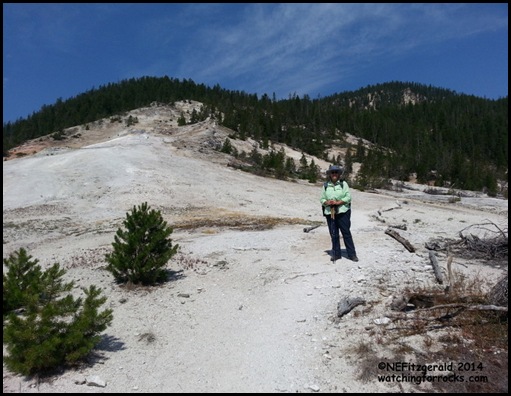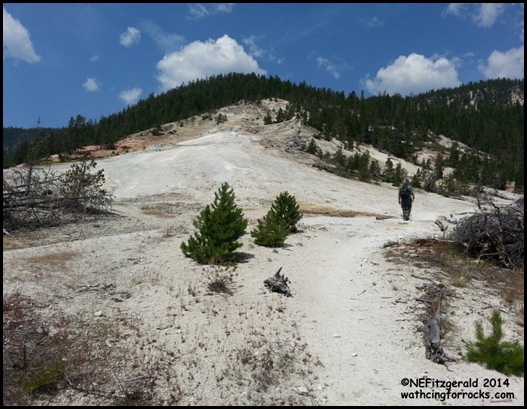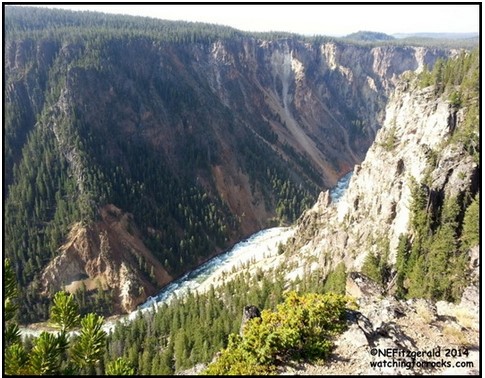A smoky haze filled the skies, drifting across Yellowstone from forest fires burning to the west of us. I did not bring binoculars, nor did I bring my bigger “good” camera. The idea was to carry as little weight as possible, down into and up out of Seven Mile Hole.
 |
| Grand Canyon of the Yellowstone River |
We both carried bear spray, of course, and hiker buddy ranger Brian brought a park radio (since there have been one or two occurrences lately in which we were involved, concerning random park visitor “rescues.” Moreover, we just never know what might happen in the backcountry…). I brought extra water, snacks, and a leftover piece of fried chicken for my lunch. My lightweight cell phone was charged, on airplane mode, and ready for pictures. Along with his pocket camera, bear spray, and radio, Brian toted a turkey with horseradish and garlic bologna sandwich for his lunch.
We were ready to rock the canyon.
 |
| Brian on the trail |
I had heard so many horror stories about the Seven Mile Hole trail in Yellowstone (the only access to the Yellowstone River for many miles through the canyon) that I wondered if I would even survive the hike. That evil south–facing wall of the canyon is so hot! There are no trees! The trail is so dreadfully steep! It’s nothing but loose, crumbly 275,000–year–old volcanic ash that has been hydrothermally altered into near oblivion! If you don’t kill yourself on the way down, you will feel like you are dying on the way up!
Nevertheless, we gathered our pluck, determined to experience Seven Mile Hole for ourselves. At first, Brian and I just wanted to get there and get back, there being the Yellowstone River as it carves its course through the depths of the Grand Canyon of the Yellowstone. Seven Mile Hole seemed a strange name for a trail that is closer to eleven miles round trip. After much speculation and random conjecture on our part, we figured that the “hole” (an old fur–trappers term for a valley) must be seven miles downstream from the Lower Falls.
 |
| Trail junction – Washburn Hot Springs and Seven Mile Hole. Here we go! |
I had hiked on an upper three–mile segment of the trail in previous summers, on jaunts from and to Washburn Hot Springs. This time, though, at a fork in the trail we went right instead of left. For this next stretch, our route would take us down to the Yellowstone River, dropping a whopping 1400 feet of elevation in a mile and a half. It was right about here that I concentrated on not thinking of that dreadful 1400–foot ascent where I might not survive to tell the tale.
 |
| There seem to be some trees along here… |
One small step after another, I channeled my inner Swiss Mountain Guide down the steeper, rocky sections and made it to a large hillside thermal area in about an hour, not very far behind Brian.
 |
| Hot thermal area ahead! |
 |
| You can’t tell how sulfurous stinky the thermals are in this image, but Brian sure knows. |
Now, Yellowstone is full of thermal areas of all sizes. This one seemed substantial as far as hillside thermal areas go, but as we waltzed through we noticed there wasn’t much action occurring besides a couple of small steaming pools and a bubbling mud pot or two. So I got to thinking (again!) about why this particular thermal area is where it is, and why it is so special.
Inside the Yellowstone caldera (a caldera is a collapsed volcanic crater), water heated at depths of up to a mile eventually makes its way to the ground surface through cracks and fractures in the rock, erupting intermittently as geysers, constantly bubbling as perpetual spouters, or steaming in seemingly placid pools. This happens within the center of the caldera, but it also happens along what is called the “ring fracture,” the edge around which the center of the volcano collapsed in on itself after the magma chamber erupted.
 |
| Blindingly white rock! Stinky sulfurous fumes! |
After studying the geologic map of Yellowstone, I noticed that the thermal area of Seven Mile Hole straddles a section of this ring fracture, as does nearby Washburn Hot Springs. Apparently, this is the reason that Seven Mile Hole’s thermal area is where it is, and is why it is so special.
 |
| Nearly to the river, Brian ponders the beauty of it all. |
As Brian and I shuffled our way closer to the river, I stopped to examine a tiny pink flower blooming next to the trail.
Hey Brian! Check out this flower.
Move! Now!
(Does he really want to see the flower that badly?)
There’s a grizzly bear!
Where?
Right. There.
Oh schist!
We scampered back up the trail, furtively glancing over our shoulders to see where in the Seven Mile Hole this grizzly bear might be moving. For a moment, I could not see anything through the underbrush, but then I saw a small black shape. Then I saw a large brown shape. Several grizzly shapes were calmly browsing in the brush less than 50 yards from where we stood with our bear spray canisters unholstered and clenched in our nervous human paws.
 |
| There are a couple of grizzlies in this… ummm… meadow? |
Back up on the plateau we had met two women backpackers coming out as we were starting down the trail. They mentioned seeing a grizzly and her cub in a meadow not far off the trail, almost to the river, and that they were able to go around the bears. Hearing this, Brian and I figured that the grizzly family would surely be gone by the time we wandered through.
With maybe a quarter mile of trail left when we saw the grizzlies, we never did get all the way to the river before Brian and I decided to turn back. It was just too risky to pass near that momma and not one but possibly two cubs. We would have had to pass them not once (on the way down to the river) but twice (again on the way back up).
No, thanks.
 |
| Heading back out and back up. Bye bye, stinky sulfur! |
By now, we were both hot, hungry, and hankering to get as far from the bears as we could. We traipsed back through that infernal thermal area again, but curiosity caused us to pause and admire from a distance a couple of steaming hot springs and a bubbling mud pot. The dry cone geyser next to the trail warranted a peek inside its blocked, rocky innards. Nearly every step we made rang with a hollow sound, as if we were moving across a drum. We were definitely walking on thin crust.
 |
| Dry cone geyser innards |
 |
| If this cavern isn’t proof of thin crust and shallow emptiness, I don’t know what is. |
The Swiss Mountain Guide in me kicked in once more as we began our ascent out of Seven Mile Hole. Step. Step. Breathe. Step. Step. Breathe. We found a shady spot where we stopped to re–fuel, Brian with his garlic bologna and me with my fried chicken. Before I knew it I was at the final switchback with its stunning view across the Grand Canyon of the Yellowstone. Only three more relatively level miles and we’d be back at the car, boots off and ready for a cool beverage at Canyon lounge.
 |
| A cool meadow along the upper trail. If there were bears here, I could surely see them! |
Honestly, it was a spectacular hike. In addition to the blindingly white, dead tree–strewn, sulfurously–smelling, nausea–inducing thermal area that we found ourselves marching across (not once but twice!), there was a wonderfully cool breeze and many tall lodgepole pines for shade along the steep, well–maintained trail. It was strenuous, that’s for sure, but not as treacherous as many folks had led me to believe. We never did get all the way to the river, but as far as I am concerned, I have hiked Seven Mile Hole. Perhaps I might just refer to it as the Six and Three–Quarters Mile Hole trail, and call it good…
 |
| The final switchback on our ascent. |






